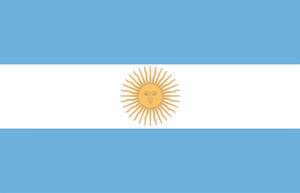Argentina Flag Facts
-
Interesting Facts for Kids 1: Argentina Flag
Argentina’s flag was designed by General Manuel Belgrano during the country’s battle for independence. The flag was first introduced in 1812. -
Interesting Facts for Kids 2: Argentina Flag
The National Flag of Argentina can be described as a triband flag featuring three equally spaced horizontal stripes. The colors, from to bottom are light blue, white, light blue. The ‘Sun of May’ was added in 1818 to centre of the flag’s design. The Sun of May is a national emblem of Argentina. The same symbol features on the flag of Uruguay also. -
Interesting Facts for Kids 3: Argentina Flag
The flag of Argentina, which features the Sun of May emblem, is known as the Official Ceremonial Flag. It is the official civil state, war flag and ensign. The Argentinean flag without the yellow Sun of May emblem is known as the Ornamental flag. This flag is seen as an alternate civil flag and ensign. Both flags are seen as the National Flag of Argentina, with the Ornamental flag being flown under the Ceremonial flag. The Sun of May symbolizes the May Revolution; a battle that sparked Argentina’s fight for independence. -
Interesting Facts for Kids 4: Argentina Flag
The origin of the flags colors can be traced back to the lead of Argentina’s fight for independence, General Belgrano. During the battle for independence, it is said, that General Belgrano realized that both his forces, and those of Spain, were using the same colors; red and yellow. The General then opted to use the colors that were used by the Criollos during the May Revolution. However, it has since been discovered that the Criollos used red, and it is therefore, more likely that the colors were taken from the House of Bourbon. -
Interesting Facts for Kids 5: Sun of May Meaning
The Sun of May emblem is a main feature of the National Flag of Argentina. It is a representation of the Inca Sun-god, Inti. The symbol has great meaning and replicates the engraving of the Sun of May on the first Argentine coin, which was approved in 1813, and valued at 8 Escudos. The sun itself is surrounded by 16 waved and 16 straight rays. The month of May forms part of the emblem’s name as it references the May Revolution that occurred in Buenos Aires, Argentina from May 18 to May 25, 1820. -
Interesting Facts for Kids 6: The Sun of May: The May Revolution 18-25th May, 1810 (Argentina’s fight for independence)
The May Revolution marked the beginning of Argentina’s fight for independence from Spain. Legend has it that the outbreak of the revolution saw the sun breaking through the clouds which was said to be a good omen. The Spanish colony incorporated parts of Argentina, Uruguay, Brazil, Paraguay and Bolivia. The May Revolution is considered the first successful revolution in South America’s battle for independence.
